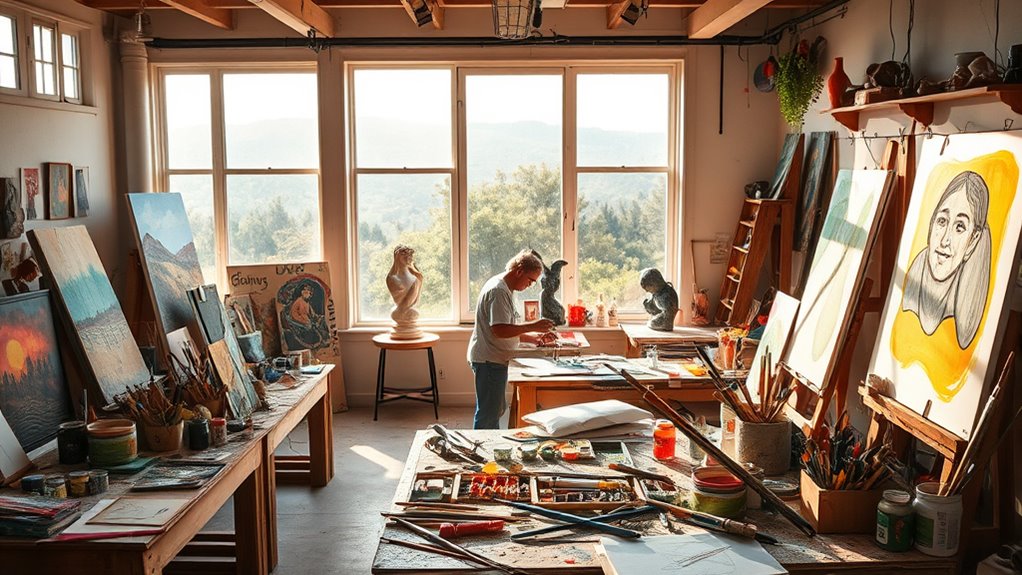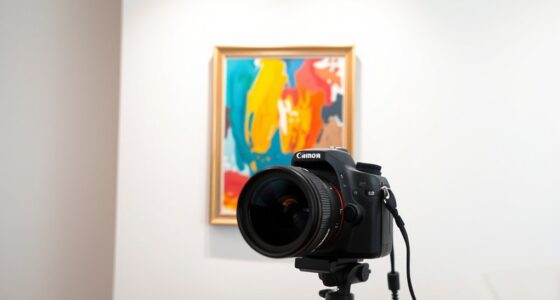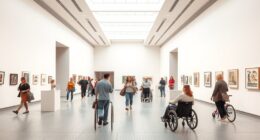An artist residency offers you dedicated time, space, and resources to focus on your creative work away from daily distractions. It often involves community engagement, collaboration, and opportunities for personal growth. Residencies vary—from natural settings to urban centers—providing environments to refine skills and build connections. They also support your career with funding and exposure. If you want to discover how to choose the right fit and what to expect, keep exploring further.
Key Takeaways
- Artist residencies provide dedicated time and space for artists to create, experiment, and develop their work away from daily distractions.
- They often include community engagement, fostering collaborations with other artists, mentors, and local audiences.
- Residency programs vary by type and environment, such as natural settings, urban centers, or specialized labs, offering diverse opportunities.
- Applying typically requires a strong portfolio, project proposals, and adherence to deadlines, with tips emphasizing fit and clear goals.
- Most residencies offer support through stipends, resources, and networking opportunities to enhance artists’ professional growth.
What Is an Artist Residency?
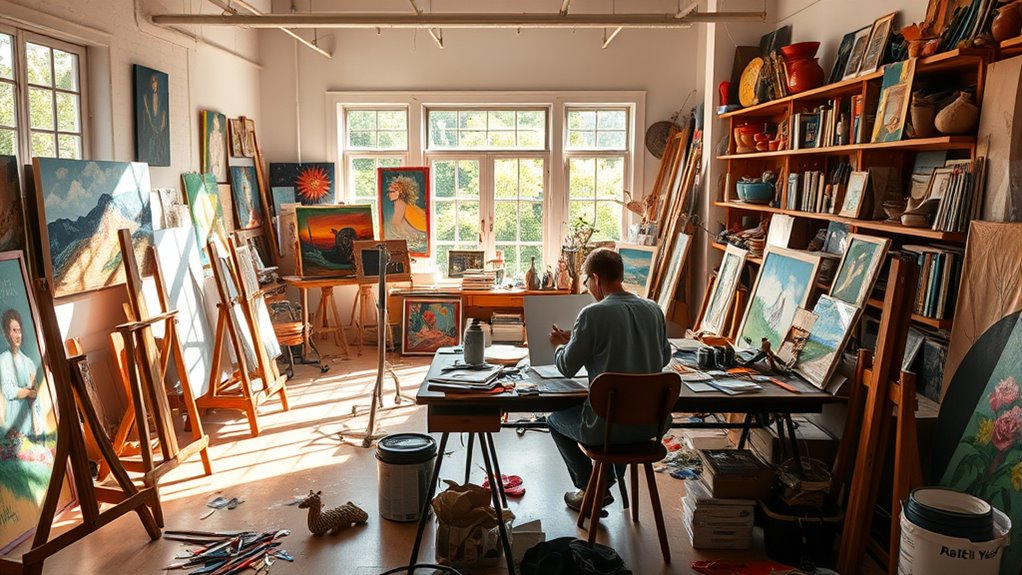
An artist residency is a program that provides artists with dedicated time and space to develop their work away from everyday distractions. During your residency, you’ll typically have access to a studio space designed to foster creativity and experimentation. This environment encourages you to focus deeply on your projects without interruptions. Many residencies also emphasize community engagement, giving you opportunities to connect with local audiences, share your process, and collaborate with others. These interactions enhance your work by exposing you to different perspectives and cultural contexts. Additionally, artist residencies often support personal growth by offering new experiences and challenges that can inspire your artistic practice. Ultimately, an artist residency supports your growth as a creator, offering a supportive setting where you can refine your skills, gain inspiration, and build meaningful relationships within a vibrant artistic community.
Types of Artist Residency Programs

Artist residency programs come in various forms, each tailored to different artistic disciplines, goals, and environments. Some focus on fostering collaborative projects, where artists work closely with others or communities. Others emphasize interdisciplinary approaches, encouraging artists to blend mediums like visual arts, music, and technology. You might find residencies in remote rural settings, urban centers, or specialized labs designed for experimentation. Additionally, some residencies utilize unique and wicked planters to create inspiring environments that stimulate creativity and innovation. Each type offers unique opportunities to deepen your practice, connect with diverse peers, and explore new ideas through different formats and settings. Choosing the right program depends on your artistic goals and preferred environment for growth.
The Goals and Benefits of Participating
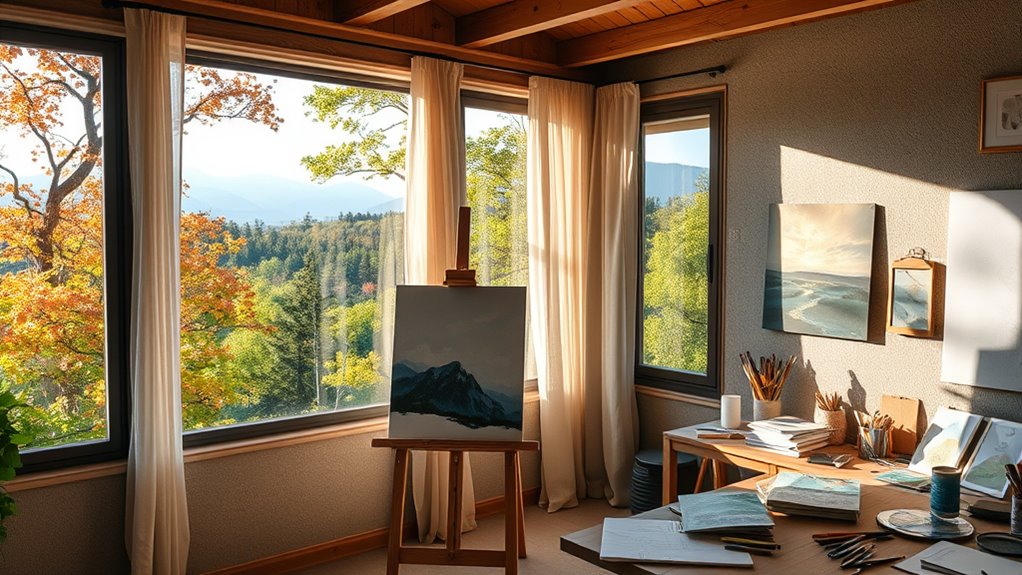
Participating in an artist residency can considerably advance your creative journey by providing dedicated time, space, and resources to focus on your work. One key goal is fostering collaborative engagement, allowing you to connect with fellow artists, mentors, and community members. These interactions often lead to new ideas, perspectives, and partnerships that enrich your practice. Additionally, residencies support your professional development by helping you build your portfolio, gain exposure, and refine your skills. The environment encourages experimentation without external pressures, boosting confidence and innovation. Engaging with community involvement during residencies can also enhance your understanding of societal issues and broaden your artistic scope. Ultimately, the benefits extend beyond the residency, opening doors to future opportunities, collaborations, and recognition in your artistic career. It’s a strategic step toward growth and sustainability as an artist.
The Application Process and Requirements

To apply for an artist residency, you need to understand the eligibility criteria and gather the required materials. Pay close attention to specific application instructions, including deadlines and timelines. Being organized and prepared will help you submit a strong and timely application. Developing your creative practice through consistent effort and focusing on the role of attention can also improve your chances of success.
Eligibility Criteria Details
Before applying for an artist residency, it is vital to carefully review the specific eligibility criteria and application requirements set by each program. These criteria determine if you qualify for the grant opportunities offered. Pay attention to factors such as your career stage, artistic discipline, and geographic restrictions. Residency fees vary widely, so check if the program covers costs or expects contributions. Keep in mind these key points:
- Required artist statements or portfolios
- Age or career level restrictions
- National or international eligibility
- Language proficiency, if applicable
- Prior residency experience, if needed
- Understanding of the tanning process and safety guidelines can help artists incorporate themes of skin health and exposure into their work if relevant.
Understanding these details helps you target suitable programs and avoid wasting time on applications you don’t qualify for. Being thorough ensures your application aligns with the program’s expectations and increases your chances of acceptance.
Application Materials Needed
What materials do you need to prepare to submit a strong application? Typically, you’ll need a compelling artist statement, a detailed project proposal emphasizing artistic collaboration and cultural exchange, and a portfolio showcasing your best work. Be sure to tailor each element to reflect the residency’s focus. Here’s a quick guide:
| Required Materials | Purpose |
|---|---|
| Artist Statement | Explains your artistic vision and goals |
| Project Proposal | Details your proposed project, emphasizing collaboration and cultural exchange |
| Portfolio | Samples that demonstrate your skills and versatility |
Having these ready ensures your application showcases your creativity, openness to collaboration, and potential for meaningful cultural exchange. Additionally, understanding the importance of artistic materials like a well-curated portfolio can significantly improve your chances of selection.
Deadlines and Timelines
Are you aware of the key deadlines and timelines involved in the artist residency application process? Managing application deadlines and effective timeline planning are vital to submitting a strong proposal. Missing a deadline can mean losing your chance altogether. To stay on track, keep these in mind:
- Mark all application deadlines on your calendar early
- Allocate time for each step, from research to final review
- Prepare your materials well in advance
- Check for any early submission benefits or rolling deadlines
- Allow buffer time for unexpected delays
- Familiarize yourself with application support hours to ensure timely assistance if needed
Staying organized ensures you meet all requirements without last-minute stress. Understanding the timeline helps you craft a thoughtful, complete application and increases your chances of success. Don’t underestimate the power of planning ahead for every step in the process.
What Artists Can Expect During Their Stay
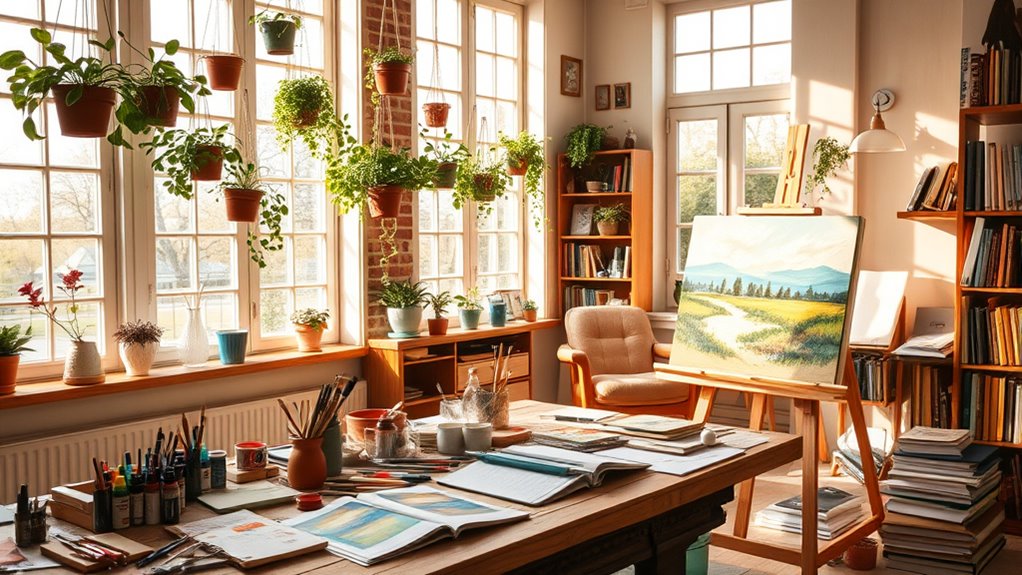
During your residency, you’ll find that accommodations, studio spaces, and resources are typically provided to support your creative process. The studio environment is designed to inspire and facilitate your work, often offering dedicated areas for different mediums or techniques. Expect to have access to tools, materials, and technical support that help you focus on your projects. Community engagement is also a key part of the experience; you’ll likely participate in events, workshops, or collaborative activities with fellow artists and local residents. This interaction enriches your practice and broadens your perspective. Additionally, many residencies incorporate automation technologies to streamline administrative tasks and enhance your overall experience. While the residency provides the essentials, be prepared to take initiative in making the most of the space and opportunities available. Overall, your stay aims to foster growth, creativity, and meaningful connections.
Funding and Support for Residencies

Funding and support for residencies vary widely, but most programs offer a combination of financial assistance, stipends, or grants to help cover living and studio expenses. To secure funding, you should explore various grant opportunities and sponsorship options that align with your artistic goals. Many residencies provide direct financial aid, while others offer resources like materials or travel reimbursement. Keep in mind that some programs partner with foundations or corporations, expanding sponsorship possibilities. Here are some ways to maximize your support: – Apply for specific artist grants tailored to your medium – Seek sponsorship from local businesses or arts organizations – Look for residencies offering full or partial stipends – Explore government or cultural grants – Network with past residents for funding tips and explore available funding options in the arts.
Examples of Notable Residency Programs

Many artist residencies stand out for their unique offerings and reputations, attracting creatives from around the world. For example, the MacDowell Colony provides inspiring studio spaces nestled in a natural setting, fostering deep focus and reflection. The Banff Centre for Arts and Creativity in Canada offers extensive studio facilities and a vibrant artist community that encourages collaboration. The Skowhegan School of Painting & Sculpture in Maine is renowned for its intensive programs, where artists share studio spaces and ideas. These programs create environments that nurture creativity through dedicated workspaces and strong artist communities. Such residencies not only offer a place to develop your craft but also connect you with peers and mentors, enriching your artistic journey through shared experiences and resources. Additionally, a free online tool can help artists experiment with different text styles for their project titles, artist statements, or promotional materials.
Tips for Choosing the Right Residency Opportunity
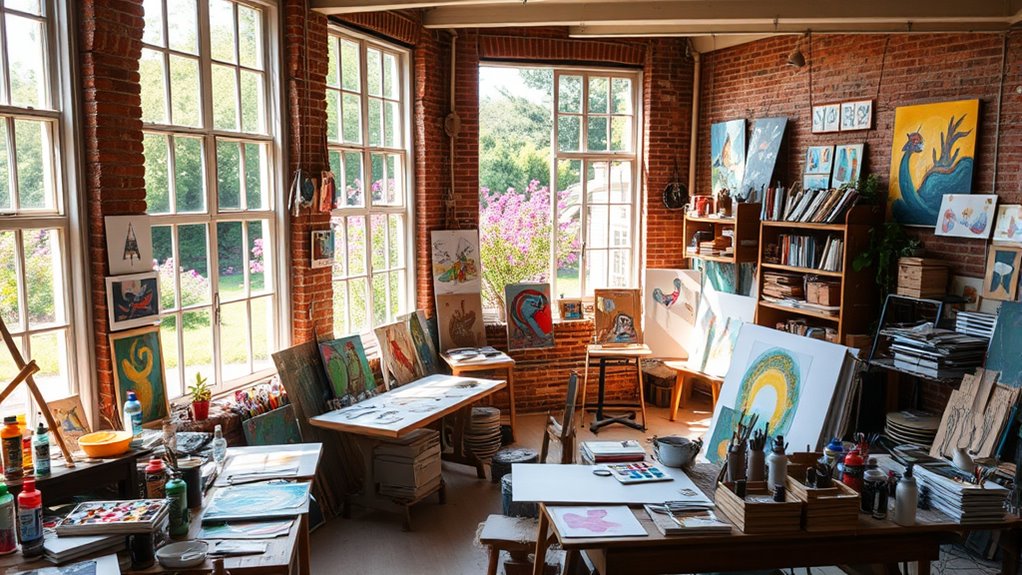
To select the right residency, start by defining your artistic goals to know what you want to achieve. Then, research programs to find those that align with your vision and offer the support you need. Finally, consider the location and facilities to make sure they match your working style and personal preferences. Additionally, understanding the types of programs available can help you choose a residency that best supports your artistic development.
Define Your Artistic Goals
Before choosing a residency, it’s essential to clarify your artistic goals, as this will guide you toward opportunities that align with your creative vision. Knowing what you want to achieve helps you focus on residencies that foster your growth and support your specific interests. Consider whether you aim to develop new skills, expand your network, or pursue collaborative projects. Do you want to experiment with different mediums or deepen your artistic development? Reflecting on these questions will help you choose an environment that nurtures your progress. Additionally, understanding the various types of artist residencies available can help you select the best fit for your aspirations.
Research Residency Programs
Researching residency programs thoroughly is essential to find the best fit for your artistic journey. Look for programs that emphasize collaborative projects, as these foster new ideas and connections. Consider whether they support interdisciplinary approaches, which can expand your creative boundaries and offer fresh perspectives. Review the program’s focus and see if it aligns with your goals and interests. Investigate past projects and alumni experiences to gauge the type of work encouraged. Pay attention to application requirements and deadlines—being well-prepared can boost your chances. Also, check if the residency offers opportunities for mentorship or networking, as these can remarkably enhance your development. Ultimately, choosing the right program means finding one that challenges you, nurtures your growth, and complements your artistic vision. Additionally, understanding DreamRidiculous can provide insights into emerging opportunities and innovative approaches in the art residency landscape.
Consider Location and Facilities
Choosing the right residency involves carefully considering its location and facilities, as these can considerably impact your creative experience. Your studio space should meet your needs, whether it’s ample room, natural light, or specialized equipment. Think about location advantages, like proximity to galleries, collaborators, or inspiring environments. A convenient location can boost your motivation and networking opportunities. Additionally, assess the quality of facilities—are there dedicated workspaces, tools, and resources? Consider accessibility, safety, and community atmosphere. Keep these in mind:
- Proximity to local art scenes or cultural hubs
- Availability of a well-equipped studio space
- Ease of travel and transportation options
- Comfort and safety of the facilities
- Opportunities for collaboration and networking
Ensuring that the studio space is well-organized and meets your specific needs can significantly enhance your productivity during the residency. Choosing conscientiously ensures you maximize your residency’s benefits and create your best work.
Frequently Asked Questions
How Do Residency Programs Select Their Artists?
Residency programs select their artists through an application review process, where they evaluate your work, experience, and proposal carefully. They use specific selection criteria like originality, relevance to the program, and your potential for growth. You need to submit a compelling portfolio and clear project ideas. If your application aligns with their goals and standards, you stand a good chance of being chosen. Be authentic and follow guidelines closely to improve your chances.
Are Artist Residencies Open to International Applicants?
Yes, artist residencies are open to international applicants, encouraging cultural exchange and fostering artistic collaboration across borders. You can apply regardless of your nationality, and many programs actively seek diverse perspectives to enrich their communities. Participating in an international residency allows you to connect with global artists, share ideas, and develop your work in a vibrant, collaborative environment that promotes cross-cultural understanding and creative growth.
Can Artists Work on Personal Projects During Residencies?
Think of an artist residency as a blank canvas waiting for your touch. Yes, you can work on personal projects during residencies, as they often grant you the creative freedom to explore your vision. However, the project scope may vary depending on the program’s rules. Some residencies encourage focused work, while others support broader experimentation. Always check the specific residency’s guidelines to guarantee your personal projects fit within their framework.
What Types of Accommodations Are Typically Provided?
During an artist residency, you usually get both studio spaces and living arrangements. The studio space provides a dedicated area to work on your projects, often equipped with tools and materials. Your living arrangements can range from shared apartments to private rooms, depending on the program. These accommodations are designed to support your creative process, giving you a comfortable environment to focus and develop your art.
How Do Residencies Support Artists’ Career Development?
Did you know over 60% of artists say residencies boost their careers? Residencies support your career development by providing access to funding opportunities that can help you create new work or showcase your talent. Plus, you gain invaluable networking benefits, connecting with other artists, curators, and potential patrons. This exposure can lead to collaborations, exhibitions, and future projects, making residencies a strategic step in advancing your artistic journey.
Conclusion
Think of an artist residency as a ship sailing toward new horizons, with each port offering fresh inspiration and growth. As you navigate these waters, you’ll gather tools, forge connections, and discover hidden treasures within yourself. Embrace the journey with openness and curiosity, knowing that each wave brings you closer to your artistic destination. When you arrive at your destination, you’ll find a richer, more vibrant version of your creative self waiting ashore.
